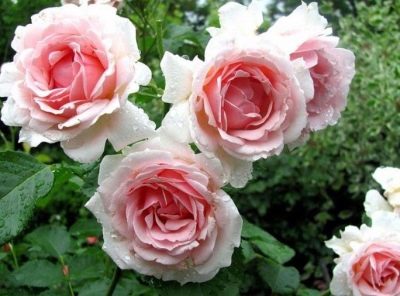
- Authors: Hans Jürgen Evers
- Name synonyms: Ballade, Kotiliesi, TANedallab
- Breeding year: 1991
- Group: floribunda
- The main color of the flower: pink
- Flower shape: cupped
- Flower size: large
- Diameter, cm: 8-10
- Scent: fruity
- Description of the bush: compact and well branching, with flexible drooping shoots
The Ballada rose variety will become an indispensable decoration for any flower bed. Brought from Germany, it began to be actively planted by domestic plant breeders several decades ago. This is a good option for a rose garden, it can be used in single plantings, since the shrubs look decent with proper care.
Breeding history of the variety
Since 1991, Russian gardeners have been able to enjoy the Ballad rose. The flower belongs to the floribunda type. Can be grown as a standard plant.
Description of the variety
The Ballad pleases with a delicate pink shade of flowers. The buds are formed on the stems of the classic cupped shape. The flowers are large, for which this variety is valued in group plantings. The diameter of one sometimes reaches 100 mm. From 3 to 5 buds are formed on one stem.
As for the aroma, the ballad rose has fruity notes. It is not very bright, rather delicate and slightly perceptible.
Particular attention to the Ballad bushes. The height of this plant rarely reaches more than 700 mm, the same amount of rose grows in width. This variety branches well, the shoots are quite flexible, nodding to the ground. Ballad's foliage is light green.
Advantages and disadvantages
Of the advantages of the described variety, it should be noted:
large flowers;
moisture resistance;
profuse flowering.
But the ballad rose variety does not withstand drought well, therefore it requires regular watering.
Flowering features
The first buds on the bushes of this variety begin to bloom in June. To delight with its beauty a rose garden with these flowers until the beginning of autumn. The ballad is a re-blooming rose, the buds open gradually.
Use in landscape design
Often the Ballad is used in landscape design. The flower looks especially good in standard form. Can be grown for cutting.
Landing
To make the Ballad feel good on the site and delight with an abundance of flowers, you should choose a sunny place for it. The soil must be properly moistened and fertilized. It is recommended to plant a rose in March or late summer, early autumn.
The soil should contain sand, peat and clay. The future state of a planted rose depends on the quality of the soil. You should not plant the Ballad in an old place where other roses have already grown before, since the soil there can be contaminated.
The soil layer at the landing site will need to be removed to a depth of 50-70 cm and filled with fresh soil with manure and mineral additives. The landing pit also for the Ballad must comply with certain rules. Width 45-50 cm, depth not less than 70 cm. Drainage and fertile layer are laid on the bottom. After planting, the flower must be watered.
Growing and care
The main care for Ballada is timely treatment against pests and diseases, high-quality watering, weed removal, pruning and the use of mulch.
Mulch is especially necessary for the plant during the period when there is not enough rain. It not only prevents weeds from germinating, but also keeps the water important for the Ballad rose at the roots.
Watering and feeding
The roots of Ballad roses penetrate deep into the soil, so signs of a lack of water appear only in case of prolonged drought. In the case of a lack of moisture, growth slows down, the shoots become thinner. One bush requires about 4-5 liters of water.Watering is best in the evening, when less moisture is lost through evaporation.
As for fertilizers, in the fall, at a distance of 8-10 cm from the trunk, to a depth of 35-40 cm, the soil is removed, and its place is filled with a mixture (2 buckets of humus, 0.5 kg of nitrophosphate, 0.5 kg of wood ash, 150 g of slaked lime). Sprinkle everything on top with peat or sawdust.
Pruning
The ballad is cut for winter, there is no need to shorten the shoots too much, 1/3 is enough. The goal of pruning is to remove old shoots each year and stimulate healthy, young growth. It must be borne in mind: all damaged, weak and frozen parts should be cut to healthy tissue, and only with a disinfected instrument.
Frost resistance and preparation for winter
Ballada rose requires shelter for the winter. This should be taken care of at the end of autumn, before the snow falls and frosts come. Mature bushes have good frost resistance, but young plantings may suffer.
The plant withstands a drop in air temperature to -23 degrees Celsius. The variety belongs to zone 6.
Diseases and pests
One of the advantages of the described flower is its high resistance to powdery mildew and black spot. But this does not mean that the plant does not need to be protected from pests and other diseases. Folk remedies such as infusion of garlic or neem oil help a lot. Fungicides for industrial purposes help well in the fight against diseases.
Reproduction
Ballad roses can be propagated by dividing the bush or cuttings. If the first method is chosen, then it is imperative to remember that both individual plants must have a good root system, therefore this method is only used for shrubs that are already several years old.
Cutting cuttings is worth in the fall. They are usually preserved until spring, or they can be immediately submerged in the soil - in a pot or in an area for a can.































































